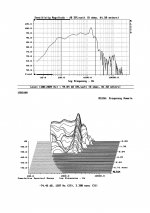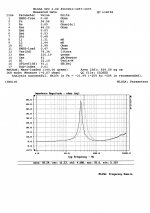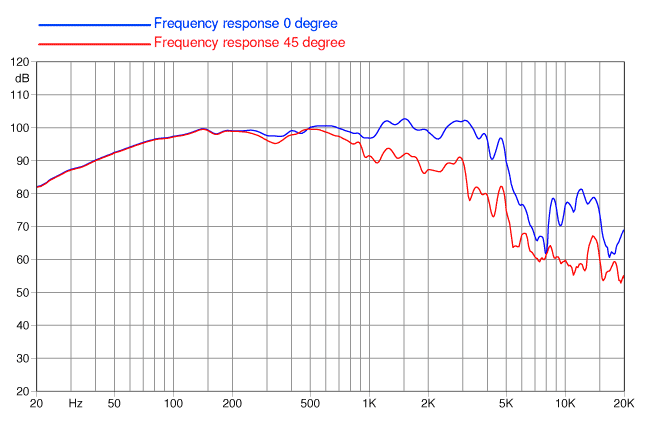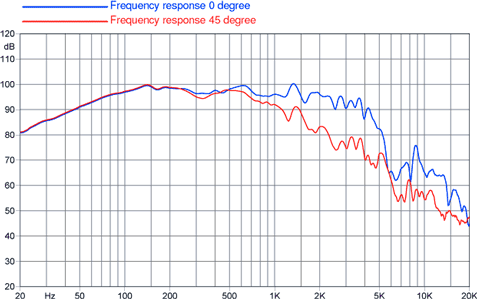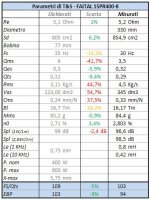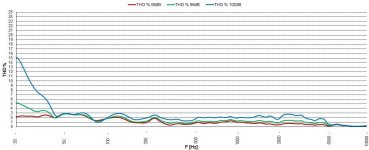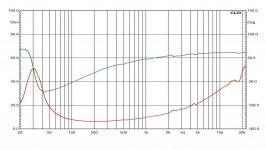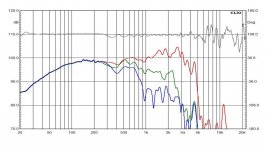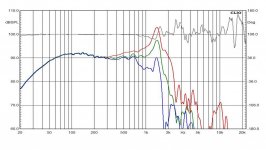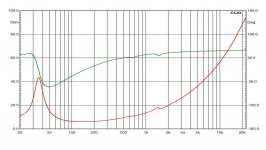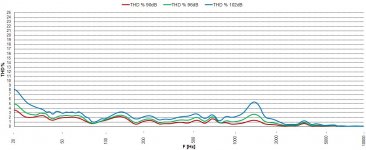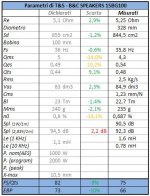https://www.prodance.cz/protokoly/12TBX100.pdf You can also find 15TBX on their site and plenty of others...Hi mabat
Did you also perform distortion measurements on the 12" tbx ?
Regards
Charles
Peter
camplo, I'm the kid who would ask the obvious questions (because I am often slow to catch onto things). Only way I can learn
Does Tony Gee's words in his documentation on his Calpamos speaker, factually incorrect and hold no merit with regards to woofer choice for a choosing a "PA woofer" for "domestic" 2-way speaker?
Not many "facts" there. Virtually the entire discussion of cone mass is presented in "audio speak" - nice words with no "factual" definitions. Statements like "opening up the midrange" are totally subjective given with absolutely no supporting evidence. This is not the way that "facts" are determined.
As with all things there are always trade-offs.....you gain constant directivity only to lose signal quality in the area of the frequency response accuracy. Yeah you can eq flat again but as I said earlier, additive eq is not a friend of signal quality and ultimately the less eq the better.....with constant directivity you gain more room interaction.....the room is a huge source of distortion....and the next best thing after a really nicely treated room is......no room....per say.
Most of this is incorrect. You do not lose "signal quality" with constant directivity, it's actually the opposite. And EQ is fine since electrical signal modifications are virtually without side effects. IOW EQ works just as expected without doing something unexpected - quite unlike acoustics.
An anechoic room sounds terrible. We need room reflections for spaciousness. And be careful about saying that "the room is a huge source of distortion" because the room is entirely linear so no "distortion products" are created. Rooms affect sound quality but entirely in the frequency domain.
It's true, the TBX100 and NBX100 clearly beat the PLB76 wrt resonances.
1 & 2: 15TBX100
3 & 4: 15NBX100
5 & 6: 15PLB76
1 & 2: 15TBX100
3 & 4: 15NBX100
5 & 6: 15PLB76
Attachments
-
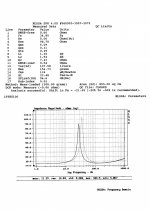 15TBX100 (Measurements)_Pagina_1.jpg405.9 KB · Views: 341
15TBX100 (Measurements)_Pagina_1.jpg405.9 KB · Views: 341 -
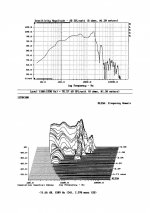 15TBX100 (Measurements)_Pagina_2.jpg523.4 KB · Views: 339
15TBX100 (Measurements)_Pagina_2.jpg523.4 KB · Views: 339 -
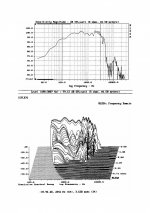 mereni_15PLB76_Pagina_2.jpg561.5 KB · Views: 78
mereni_15PLB76_Pagina_2.jpg561.5 KB · Views: 78 -
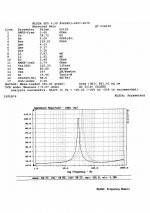 mereni_15PLB76_Pagina_1.jpg417.8 KB · Views: 83
mereni_15PLB76_Pagina_1.jpg417.8 KB · Views: 83 -
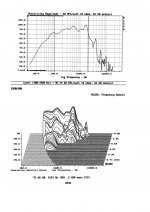 mereni_BC_Speakers_15NBX100_Pagina_1.jpg611.3 KB · Views: 329
mereni_BC_Speakers_15NBX100_Pagina_1.jpg611.3 KB · Views: 329 -
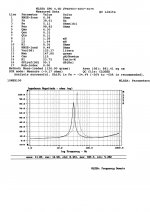 mereni_BC_Speakers_15NBX100_Pagina_2.jpg450.8 KB · Views: 332
mereni_BC_Speakers_15NBX100_Pagina_2.jpg450.8 KB · Views: 332
Last edited:
No, it isn't
15TBX100:
voice coil:4"=100mm
MMS:>150gr
I don't see an advantage for home use !?!?
I didn't say a word about a voice coil diameter and it's not the reason I would prefer the driver. It may be a bit of overkill but it does no harm either.
The higer Mms comes from the fact that extreme excursions (and forces) are expected during the intended use so the cone must be rigid enough - you just can't do it with a light cone. As a byproduct, the moving parts are also quite well damped - that also requires some mass to be effective. When this all comes together, it makes quite a good midrange driver (only without the sensitivity for a dedicated PA midrange). At least this is how I see it.
The higer Mms comes from the fact that extreme excursions (and forces) are expected during the intended use so the cone must be rigid enough - you just can't do it with a light cone. As a byproduct, the moving parts are also quite well damped - that also requires some mass to be effective. When this all comes together, it makes quite a good midrange driver (only without the sensitivity for a dedicated PA midrange). At least this is how I see it.
Last edited:
The point of this discussion mainly concerns amplifier power and usable bandwidth.
You won't be able to breath life into either the TBX100, NBX100, or BG100 with a low power SET or solid state Class A amplifier.
While the 15PR400 is more efficient than all of the B&Cs mentioned above, the difference isn't exactly night and day.
IOW, the 15PR400 needs at least a healthy 50 Watt or 25 Watt Class A.
The 15PR400's response extends further, so it is the better driver for a XO >800Hz.
You won't be able to breath life into either the TBX100, NBX100, or BG100 with a low power SET or solid state Class A amplifier.
While the 15PR400 is more efficient than all of the B&Cs mentioned above, the difference isn't exactly night and day.
IOW, the 15PR400 needs at least a healthy 50 Watt or 25 Watt Class A.
The 15PR400's response extends further, so it is the better driver for a XO >800Hz.
Last edited:
I'd like to see a comparison where the sound pressure level is matched, and there is a much higher resolution waterfall plot to see energy storage in the drivers. The fact is that the 15PLB76 is more than a full 3 dB louder than the other two drivers as indicated on the measurement sheets. At 800 hz, 1 period is 1.25 msec. 600 hz, 1 period is 1.67 msec. What about group delay added from the plurality of filters to deal with the ugly native response, or the added 'sound' radiated from the cabinet. These are other maladities that need remedies when considering a 'system' with any of the drivers in question. 3 dB more amplifier needed for the same sound pressure will raise currents in the coil, and these must be dealt with by a lower distortion motor system.
The 15PR400's response extends further, so it is the better driver for a XO >800Hz.
Why? And why would you do that?
Gedlee -
Turns out that the "subtractive eq is best" is a myth that I've held on to...it is based in truth from once upon a time but still, I suggest that no eq is better than having to eq. Unless using linear equalization, eq does cause phase shift, and if you are using room correction, wouldn't a scenario where the left channel needed significantly different boost/attention than the right channel, cause phase complications that would make for a higher variance of result as opposed to listening position
I was exaggerating about "no room" maybe I should of said less room? A reflection is a distortion....if its not identical to the source signal in spl or timing.....essentially it is a distortion to the gravest sense of the definition of the word even if a certain level of distortion is perceived as natural.
Distortion - : falsified reproduction of an audio or video signal (see SIGNAL entry 1 sense 4b) caused by change in the wave form of the original signal
"Rooms affect sound quality but entirely in the frequency domain" Constant Directivity horns affect sound quality....in the frequency domain, not in a good way.
Thanks for the correcting information. Correct away
Turns out that the "subtractive eq is best" is a myth that I've held on to...it is based in truth from once upon a time but still, I suggest that no eq is better than having to eq. Unless using linear equalization, eq does cause phase shift, and if you are using room correction, wouldn't a scenario where the left channel needed significantly different boost/attention than the right channel, cause phase complications that would make for a higher variance of result as opposed to listening position
I was exaggerating about "no room" maybe I should of said less room? A reflection is a distortion....if its not identical to the source signal in spl or timing.....essentially it is a distortion to the gravest sense of the definition of the word even if a certain level of distortion is perceived as natural.
Distortion - : falsified reproduction of an audio or video signal (see SIGNAL entry 1 sense 4b) caused by change in the wave form of the original signal
"Rooms affect sound quality but entirely in the frequency domain" Constant Directivity horns affect sound quality....in the frequency domain, not in a good way.
Thanks for the correcting information. Correct away
If you're 'all (digital) active', like me, the power requirements are not an issue.
A decent Powersoft on the woofer and tubes on the comp. driver provide the desired characteristics and qualities to each driver.
For those who (still) prefer passive, it's a different story.
I wouldn't, but some people want to combine an 1" with a 15".
More to follow.
Unless you want to passively bi-amp.
A decent Powersoft on the woofer and tubes on the comp. driver provide the desired characteristics and qualities to each driver.
For those who (still) prefer passive, it's a different story.
Why? And why would you do that?
I wouldn't, but some people want to combine an 1" with a 15".
More to follow.
For those who (still) prefer passive, it's a different story.
Unless you want to passively bi-amp.
Here are some (independent) measurements of the FaitalPRO 15PR400.
Response, impedance, THD and interestingly: specified versus measured T&S parameters.
Response, impedance, THD and interestingly: specified versus measured T&S parameters.
Attachments
Last edited:
The same data of the B&C 15BG100 (as used by Vance Dickason):
Attachments
Last edited:
I can't find the 15TBX100 anymore but found my measurement of the raw 12TBX100. This is almost perfect, IMO. What more would anyone want? Of course the crossover won't be easy and no textbook filters will do it, but they never do, the less with these kinds of designs with horns. If someone claims that you need low moving mass for high quality midrange I would ask how do they know. For me it's just so obvious that it doesn't really matter that I can't imagine to be otherwise. Lighter membranes typically just store more energy (i.e. they resonate/ring) at the midrange. Why would anyone consider it better?
Story that lower Mms woofers have more open sound is yesterdays news.
In my experience story about high and low Mms woofers is confusing because of many factors. Main one being room/distance from where it is listened. High Mms woofers do not act linear in regard to how much power they receive. While i play it in my room (and i have designed few 2 way waveguide loaded loudspeakers) there is a threshold for high Mms woofers when it begins to sound alive. That difference depends not only on Mms but on Cms to. So when you put the room in to equation, you see where all of the confusion origins. If i try (as i have) to listen two way loudspeaker using Beyma SM115K and 18" oswg with B&C DE250-8 and with crossover frequency at 900Hz in my room of 17sqm, it sounds muddy at normal listening levels. As i begin to turn it up more and more, when i get to about 5W it starts to come alive. When i bring the speakers to my friend that doesn't live in a flat but in a house with 50sqm living room, it sounds very much alive when we get to normal listening level. If we would be listening those loudspeakers in our rooms not knowing about each other, we would write diametrically different impressions of sound on forum.
Low Cms and large Mms inevitably lead to some inertia. Although efficient, they require few watts to sound their best. Problem when using it in smaller spaces is that, when you turn them up so they come alive, it is to loud to be in that room. Woofers being used today are meant for 500-1000W or even more. Watts are cheap these days. Manufacturers do not stress themselves for how do their products sound at low level playback. Altec woofers (todays Great Plains Audio) makes woofers as they did in the old days when 20W of tube power was all that was available for one channel. That is why those vintage woofers have low Le, Mms and high Cms and Qms. They were designed with tube amplifier power rating in mind and for lots of people that is maximum they can endure in their listening environments because of room size.
In conclusion, of course that new age woofers sound better with more juice in them and in larger venues - they are built for that as their primary purpose. Or maybe i'm just babbling. It's up to you to decide.
Last edited:
- Home
- Loudspeakers
- Multi-Way
- Is it possible to cover the whole spectrum, high SPL, low distortion with a 2-way?

